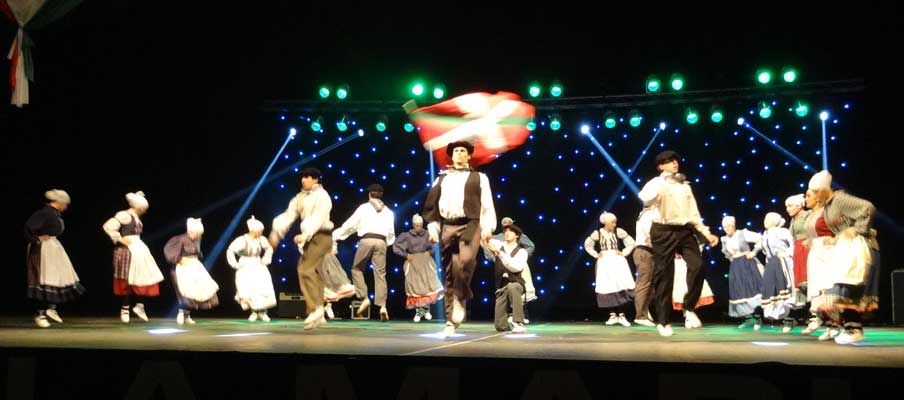basque heritage worldwide

11/13/2013

ADVERTISING
Villa Maria, Argentina. There are many ways to maintain our culture outside of the Basque country but without a doubt, Euskera and dance are the expressions that are practiced most vigorously by members of the Diaspora, in such a way that dancing and language classes make up the largest part of the activity of a large number of Basque clubs. Other tasks, such as libraries are also vital in spreading the Basque culture, Basque language, dances, libraries but also music and games on Saturday afternoon in Villa Maria.

[Deluge outside – it poured – but inside sokatira! Txikis and not so txikis united to play, participate and measure their strength (photoEuskalKultura.com)]

[After the games the Basque language activities began. To start, Baietz from Cordoba sang and made others sing in Basque (photoEuskalKultura.com)]

[Continuing with Basque, a student of Euskara Munduan, Gabriela Aguirre, gave a short stand up session. This member of Gerora explained what it meant to be a “euskal diasporatarra” with humor (photoEuskalKultura.com)]

[As every year the annual librarian meeting was held. The event was a good opportunity to talk about what has been accomplished and what is left to be done. Seen here, the participants in the library meeting along with Marta Abarrategui and Ricardo Basterra, secretary and president of FEVA respectively (photoEuskalKultura.com)]

[Elsewhere in the clubhouse, there was a talk-debate on Euskadi with Andoni Ortuzar, president of the Euzkadi Buru Batzar of EAJ-PNV and Iker Urbina, deputy of Amaiur in Madrid (photoEuskalKultura.com)]

[In the afternoon, before the dancing started, the Tamborrada from Donostia was heard in the Villa Maria Amphitheater. Thanks to directors Jose Maria Gutierrez and Rosana Entizne, tamborreros from Laurak Bat in Buenos Aires, Union Vasca from Bahia Blanca, the Zazpi from Rosario and Euzkal Etxea in San Nicolas brought the most well-known sounds of Gipuzkoa to the Argentinean province of Cordoba (photoEuskalKultura.com)]

[At the beginning of Saturday’s evening show, a group of skaters carried the Basque and Argentinean flags to the stage. Following dancers from Villa Maria (seen here) opened the show with Aurresku (photoEuskalKultura.com)]

[Next another group from Villa Maria, the txikis, performed kuadrille (photoEuskalKultura.com)]

[The intermediates from Villa Maria also participated in the Gala. They performed Makil Dantza (photoEuskalKultura.com)]

[The group from Buenos Aires, Ekin Dantzari Taldeak danced Arratiako Jota(photoEuskalKultura.com)]

[From the capital of Cordoba, the kids from Txotx! danced their Hemengo Jauzi with live music provided by their friends from Baietz (photoEuskalKultura.com)]

[Thanks to the dantzaris from Tres Arroyos, Uztai Handiak (photoEuskalKultura.com)]

[The youth from Lomas de Zamorako performed Gipuzkoako Ezpatadantza at the Semana Vasca 2013 (photoEuskalKultura.com)]

[The dancers from Tandil performed Zuberoako Makil Dantza (photoEuskalKultura.com)]

[Members of Toki Eder in Jose C. Paz also took the stage and performed Eltziegoko Dantza(photoEuskalKultura.com)]

[The most colorful dance, without a doubt, was the Carnaval de Lantz by the Concordia Basque club (photoEuskalKultura.com)]

[Dantzaris from Beti Aurrera in Chivilcoy did Urarte (photoEuskalKultura.com)]

[And those from Chacbuco offered the public their version of Neskatxena (photoEuskalKultura.com)]

[Next it was the Gure Txokoa dancers’ turn that performed Azken Dantza (photoEuskalKultura.com)]

[The Union Vasca club in Bahia Blanca took to the stage twice. They performed Hator Hator and then the Maskarada Suletina near the end (photoEuskalKultura.com)]

[The first part of the show was closed by the hosting club’s dancers. The oldest dancers from Villa Maria among them the members of the board of directors led by its president Ismael Martinez de Alegria showed that they are still in great shape and performed Arku Dantza (photoEuskalKultura.com)]

[Before intermission, Basque students were awarded certificates from HABE for improving their level of Basque. Marian Elorza, Ricardo Basterra and Ismael Martinez de Alegria were those in charge of making the presentations to those students/professors who could travel to Villa Maria (photoEuskalKultura.com)]
[Second part of the evening tomorrow]
ADVERTISING
ADVERTISING
ADVERTISING
ADVERTISING
ADVERTISING
© 2014 - 2019 Basque Heritage Elkartea
Bera Bera 73
20009 Donostia / San Sebastián
Tel: (+34) 943 316170
Email: info@euskalkultura.eus